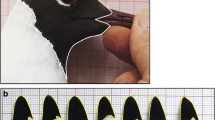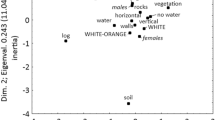Abstract
Previous work with a colour polymorphic population of Podarcis muralis (Lacertidae) revealed that lizards pair by ventral colour, favouring the same colour (i.e. homomorphic) pairs. Such assortative pairing, which probably results in colour assortative mating, can have consequences for the genetic structure of the population and potentially promote speciation. The population previously studied, located in the Pyrenees, encompasses white, yellow and orange animals, as well as intermediate white–orange and yellow–orange morphs. However, other Pyrenean populations of P. muralis have less ventral colour morphs. Our aim in this study is to test the generality of the assortative colour pairing system, extending our previous analyses to populations with different morph compositions and frequencies. The results show that the assortative pattern of pairing is similar in all the populations analysed and, hence, independent of morph composition and not restricted to pentamorphic populations. This suggests that assortative pairing by colour is a general phenomenon for colour polymorphic populations of P. muralis.



Similar content being viewed by others
References
Arnold EN, Ovenden D (2002) A field guide to the reptiles and amphibians of Britain and Europe, 2nd edn. Collins, London
Bellati A (2011) Genetic survey of polymorphic populations of Podarcis muralis (Sauria: Lacertidae) using molecular markers. Scientifica Acta 5:46–54
Bleay C, Sinervo B (2007) Discrete genetic variation in mate choice and a condition-dependent preference function in the side-blotched lizard: implications for the formation and maintenance of coadapted gene complexes. Behav Ecol 18:304–310. doi:10.1093/beheco/arl101
Calsbeek B, Hasselquist D, Clobert J (2010) Multivariate phenotypes and the potential for alternative phenotypic optima in wall lizard (Podarcis muralis) ventral color morphs. J Evol Biol 23:1138–1147. doi:10.1111/j.1420-9101.2010.01978.x
Cheylan M (1988) Variabilité phénotypique du lézard des murailles Podarcis muralis sur les îles de la côte provençale. Rev Écol 43:287–321
Chunco AJ, McKinnon JS, Servedio MR (2007) Microhabitat variation and sexual selection can maintain male color polymorphisms. Evolution 61:2504–2515. doi:10.1111/j.1558-5646.2007.00213.x
Corl A, Davis AR, Kuchta SR, Sinervo B (2010) Selective loss of polymorphic mating types is associated with rapid phenotypic evolution during morphic speciation. Proc Natl Acad Sci U S A 107:4254–4259. doi:10.1073/pnas.0909480107
Edsman L (1990) Territoriality and competition in wall lizards. University of Stockholm, Stockholm
Fitze PS, González-Jimena V, San-José LM, Heulin B, Sinervo B (2014) Frequency-dependent sexual selection with respect to offspring fitness returns is consistent with predictions from rock-paper-scissors dynamics in the European common lizard. Front Ecol Evol 2:77. doi:10.3389/fevo.2014.00077
Font E, Carazo P, Pérez i de Lanuza G, Kramer M (2012) Predator-elicited foot shakes in wall lizards (Podarcis muralis): Evidence for a pursuit-deterrent function.. Journal of Comparative Psychology 126(1):87–96. doi:10.1037/a0025446
Galeotti P, Sacchi R, Pellitteri-Rosa D, Bellati A, Cocca W, Gentilli A, Scali S, Fasola M (2013) Colour polymorphism and alternative breeding strategies: effects of parent’s colour morph on fitness traits in the common wall lizard. Evol Biol 40:385–394. doi:10.1007/s11692-012-9222-3
Gruschwitz M, Böhme W (1986) Podarcis muralis—Mauereidechse. In: Böhme W (ed) Handbuch der Reptilien und Amphibien Europas, Band 2/II., Echsen III (Podarcis). Aula-Verlag, Wiesbaden, pp. 155–208
Heathcote RJ, While GM, MacGregor HE, Sciberras J, Leroy C, D’Ettorre P, Uller T (2016) Male behaviour drives assortative reproduction during the initial stage of secondary contact. J Evol Ecol. doi:10.1111/jeb.12840
Hugall AF, Stuart-Fox D (2012) Accelerated speciation in color-polymorphic birds. Nature 485:631–634. doi:10.1038/nature11050
Huyghe K, Vanhooydonck B, Herrel A, Tadić Z, Van Damme R (2007) Morphology, performance, behavior and ecology of three color morphs in males of the lizard Podarcis melisellensis. Integr Comp Biol 47:211–220. doi:10.1093/icb/icm043
Lattanzio MS, Metro KJ, Miles DB (2014) Preference for male traits differ in two female morphs of the tree lizard, Urosaurus ornatus. PLoS One 9:e101515. doi:10.1371/journal.pone.0101515
McKinnon JS, Pierotti ME (2010) Color polymorphism and correlated characters: genetic mechanisms and evolution. Mol Ecol 19:5101–5125. doi:10.1111/j.1365-294X.2010.04846.x
McLean CA, Stuart-Fox D (2014) Geographic variation in animal color polymorphisms and its role in speciation. Biol Rev 89:860–873. doi:10.1111/brv.12083
McLean CA, Stuart-Fox D, Moussalli A (2015) Environment, but not genetic divergence, influences geographic variation in color morph frequencies in a lizard. BMC Evol Biol 15:156. doi:10.1186/s12862-015-0442-x
Olsson M, Stuart-Fox D, Ballena C (2013) Genetics and evolution of color patterns in reptiles. Sem Cell Dev Biol 24:529–541. doi:10.1016/j.semcdb.2013.04.001
Pellitteri-Rosa D, Martín J, López P, Bellati A, Sacchi R, Fasola M, Galeotti P (2014) Chemical polymorphism in male femoral gland secretions matches polymorphic coloration in common wall lizards (Podarcis muralis). Chemoecology 24:67–78. doi:10.1007/s00049-014-0148-3
Pérez i, de Lanuza G, Font E, Carazo P (2013) Color assortative mating in a color polymorphic lacertid lizard. Behav Ecol 24:273–279. doi:10.1093/beheco/ars164
Pérez i, de Lanuza G, Carazo P, Font E (2014) Colors of quality: structural (but not pigment) coloration informs about male quality in a polychromatic lizard. Anim Behav 90:73–81. doi:10.1016/j.anbehav.2014.01.017
Pérez i, de Lanuza G, Font E (2015) Differences in conspicuousness between alternative color morphs in a polychromatic lizard. Behav Ecol 26:1432–1446. doi:10.1093/beheco/arv075
Pérez i, de Lanuza G, Carretero MA, Font E (2016) Thermal dependence of signalling: do polymorphic wall lizards compensate for morph-specific differences in conspicuousness? Behav Ecol Sociobiol 70:1151–1159. doi:10.1007/s00265-016-2123-1
Pryke SR, Griffith SC (2007) The relative role of male vs. female mate choice in maintaining assortative pairing among discrete color morphs. J Evol Biol 20:1512–1521. doi:10.1111/j.1420-9101.2007.01332.x
Rankin K, Stuart-Fox D (2015) Testosterone-induced expression of male color morphs in females of the polymorphic tawny dragon lizard, Ctenophorus decresii. PLoS One 10:e0140458. doi:10.1371/journal.pone.0140458
Roulin A (2004) The evolution, maintenance and adaptive function of genetic color polymorphism in birds. Biol Rev 79:815–848. doi:10.1017/S1464793104006487
Roulin A, Bize P (2007) Sexual selection in genetic color-polymorphic species: a review of experimental studies and perspectives. J Ethol 25:99–105. doi:10.1007/s10164-006-0006-z
Runemark A, Hansson B, Pafilis P, Valakos ED, Svensson EI (2010) Island biology and morphological divergence of the Skyros wall lizard Podarcis gaigeae: a combined role for local selection and genetic drift on color morph frequency divergence? BMC Evol Biol 10:269. doi:10.1186/1471-2148-10-269
Sacchi R, Rubolini D, Gentilli A, Pupin F, Razzetti E, Scali S, Galeotti P, Fasola M (2007a) Morph-specific immunity in males of the common wall lizard, Podarcis muralis. Amphibia-Reptilia 28:408–412. doi:10.1163/156853807781374700
Sacchi R, Scali S, Pupin F, Gentilli A, Galeotti P, Fasola M (2007b) Microgeographic variation of color morph frequency and biometry of common wall lizards. J Zool 273:389–396. doi:10.1111/j.1469-7998.2007.00342.x
Sacchi R, Pupin F, Gentilli A, Rubolini D, Scali S, Fasola M, Galeotti P (2009) Male-male combats in a polymorphic lizard: residency and size, but not color, affect fighting rules and contest outcome. Aggress Behav 35:274–283. doi:10.1002/ab.20305
Sacchi R, Ghitti M, Scali S, Mangiacotti M, Zuffi MA, Sannolo M, Coladonato AJ, Pasquesi G, Bovo M, Pellitteri-Rosa D (2015) Common wall lizard females (Podarcis muralis) do not actively choose males based on their color morph. Ethology 121:1145–1153. doi:10.1111/eth.12431
Salvi D, Harris DJ, Kaliontzopoulou A, Carretero MA, Pinho C (2013) Persistence across Pleistocene ice ages in Mediterranean and extra-Mediterranean refugia: phylogeographic insights from the common wall lizard. BMC Evol Biol 13:147. doi:10.1186/1471-2148-13-147
Scali S, Sacchi R, Azzusi M, Daverio S, Oppedisano T, Mangiacotti M (2013) Homeward bound: factors affecting homing ability in a polymorphic lizard. J Zool 289:196–203. doi:10.1111/j.1469-7998.2012.00977.x
Scali S, Sacchi R, Mangiacotti M, Pupin F, Gentilli A, Zucchi C, Sannolo M, Pavesi M, Zuffi MAL (2016) Does a polymorphic species have a ‘polymorphic’ diet? A case study from a lacertid lizard. Biol J Linn Soc 117:492–502. doi:10.1111/bij.12652
Schulte U (2008) Die Mauereidechse. Laurenti Verlag, Bielefeld
Schulte U, Beninde J (2013) Polymorphismus der Bauchfärbung evolutionärer Linien der Mauereidechse in Deutschland. Z Feldherpetologie 20:209–213
Sinervo B, Lively CM (1996) The rock-paper-scissors game and the evolution of alternative male reproductive strategies. Nature 380:240–243. doi:10.1038/380240a0
Sinervo B, Zamudio KR (2001) The evolution of alternative reproductive strategies: fitness differential, heritability, and genetic correlation between sexes. J Hered 92:198–205. doi:10.1093/jhered/92.2.198
Wellenreuther N, Svensson EI, Hansson B (2014) Sexual selection and genetic color polymorphisms in animals. Mol Ecol 23:5398–5414. doi:10.1111/mec.12935
Acknowledgments
GPL was supported by a post-doctoral grant (SFRH/BPD/94582/2013) from FCT (Fundação para a Ciência e a Tecnologia, Portugal) under the Programa Operacional Potencial Humano—Quadro de Referência Estratégico Nacional funds from the European Social Fund and Portuguese Ministério da Educação e Ciência. The study was supported by FEDER funds through the Operational Programme for Competitiveness Factors—COMPETE and by National Funds through, by the FCT project FCOMP-01-0124-FEDER-008929 PTDC/BIA-BEC/101256/2008 and by a grant (CGL2011-23751) from the Spanish Ministerio de Ciencia e Innovación.
Author information
Authors and Affiliations
Corresponding author
Additional information
Communicated by: Sven Thatje
Rights and permissions
About this article
Cite this article
Pérez i de Lanuza, G., Font, E. & Carretero, M.Á. Colour assortative pairing in a colour polymorphic lizard is independent of population morph diversity. Sci Nat 103, 82 (2016). https://doi.org/10.1007/s00114-016-1407-7
Received:
Revised:
Accepted:
Published:
DOI: https://doi.org/10.1007/s00114-016-1407-7




